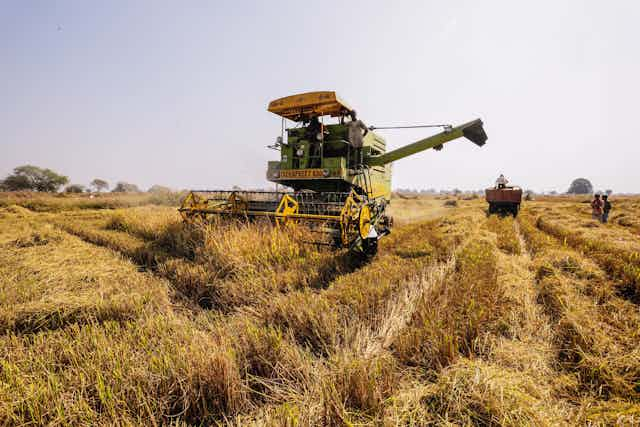Environmental problems are usually multifaceted and complex. This is especially true for climate change. As a result, over time researchers and policymakers have learned the importance of a comprehensive and multi-pollutant approach meant to solve different problems at once.
At the COP21 Paris climate summit, negotiators were successful to a certain extent in bringing air pollution and climate change more holistically in the same framework. This is important as emerging developing countries, such as China and India, have a higher priority in mitigating air pollution. And rightly so, with their constant exposure to high air pollutant concentrations.
But a similarly integrated approach appears to have failed for agriculture despite tremendous opportunities. It is a shame that we have not been successful at crystallizing a concrete agreement to reduce greenhouse gases that produced a win-win for agriculture and climate.
Climate pollutants
At COP21, the Climate and Clean Air Coalition (CCAC) – a partnership of governments, nongovernmental organizations (NGOs) and other organizations – was successful in committing to accelerate ambitious action to reduce short-lived climate pollutants (SLCPs).
These SLCPs, including the greenhouse gas methane (CH4) and particles from combustion called black carbon (BC), are important for reducing air pollution and climate change. They both warm the atmosphere and degrade air quality.
Particles including black carbon are often called fine particles or PM2.5 (particulate matter smaller than 2.5 micrometers). They are the culprits of the smog we have been seeing recently in China.
CH4 is a precursor of ozone (O3) in the lower atmosphere, an oxidant, and unlike the stratospheric O3 that protects us from the ultraviolet radiation, it is harmful to health, contributes to smog, and also damages crop yields.
The agreement in Paris is an important step toward achieving benefits in the near future. Most greenhouse gases (GHGs) such as carbon dioxide (CO2) are long-lived in the atmosphere. These SLCPs, in contrast, have a lifetime of a couple of weeks (BC) to a decade (CH4). So, by reducing these short-lived air pollutant emissions, we will be able to enhance air quality and improve human health and agricultural yields much more quickly.
Research by Duke University’s Drew Shindell and others estimates that the mitigation measures targeting these two pollutant emissions – CH4 and BC – will not only reduce global mean warming by 0.5 degrees Celsius by 2050 but also avoid 0.7-4.7 million annual premature deaths.
Furthermore, the study projects a significant increase of 30-135 million metric tons of annual crop yields.
The Asian Development Bank’s US$300 million loan to China to combat pollution is also along the same lines. It is targeted to reducing air pollution, but because it is mainly for cutting coal use, it will obviously also reduce its carbon emissions. One caveat, though, is that pollutants that scatter sunlight and thus cool the atmosphere, such as sulfate aerosols, will also be reduced. It is almost never possible to have a perfectly rosy solution.
Soil emissions
Although the COP included initiatives targeting air pollution, climate and health all at once, there was a lack of comprehensive strategy for the interlinked effects of climate and agriculture at the summit.
Agriculture contributes 10%-12% of global anthropogenic greenhouse gas (GHG) emissions, and it has altered all of the three important greenhouse gases linked to terrestrial sources: CO2, CH4 and nitrous oxide (N2O). The flip side is that there is a significant potential in agriculture for reducing these biogenic sources of greenhouse gases.
The agricultural sector is also important because we need to pay more attention to nitrous oxide – possibly the least-known important GHG. N2O is not just a GHG; it also depletes the ozone layer in the stratosphere.
The Montreal Protocol, which was ratified in 1989, has been effective at reducing greenhouse gases that are also ozone-depleting substances (Velders et al, 2006). However, N2O is not included in the Montreal Protocol, and its emissions are sharply rising.
The concentrations of N2O in the atmosphere are increasing rapidly and we find that there is a statistically significant increase in emissions from the agricultural sector in Asia, including China and India. This makes sense, as the nitrogen fertilizer usage in these countries is the largest and the third-largest in the world and is only increasing.
There is a need for a better understanding of how the net greenhouse gas balance from terrestrial sources changes as a result of agricultural practices. We need to commit ourselves to finding good agricultural practices in different areas of the world that could minimize soil GHG emissions.
Much as we’ve found the co-benefits of reducing air pollution and greenhouse gases, we need to commit ourselves to finding good agricultural practices in different areas of the world that could minimize soil GHG emissions, provide sufficient food and improve soil quality.
The term climate-smart agriculture was coined in 2010 to describe a system that increases productivity, builds resilience, and reduces GHG emissions. Now is the time to really take it seriously before it is too late. The action has to start in developed countries.

